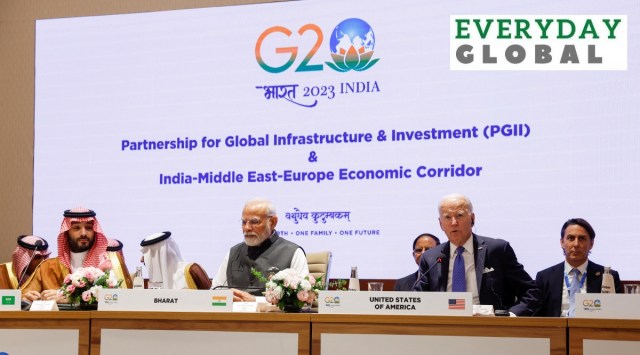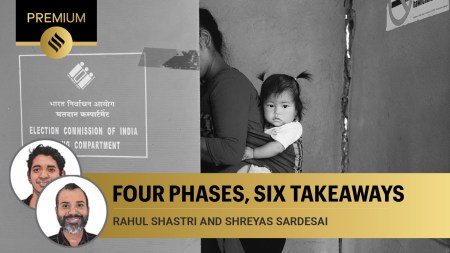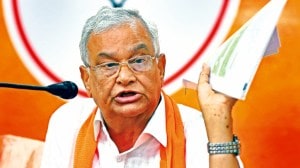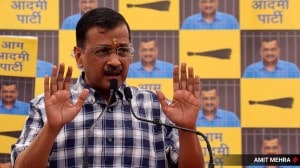- India
- International
India-Europe Economic Corridor: What is the Partnership for Global Infrastructure Investment that is behind the project?
The new project is a part of the Partnership for Global Infrastructure Investment (PGII) – a West-led initiative for funding infrastructure projects across the world, seen as a counter to China’s Belt and Road Initiative (BRI).
 Saudi Arabian Crown Prince Mohammed bin Salman Al Saud, Indian Prime Minister Narendra Modi and U.S. President Joe Biden attend Partnership for Global Infrastructure and Investment (PGII) event on the day of the G20 summit in New Delhi, India, September 9, 2023. (REUTERS/Evelyn Hockstein/Pool)
Saudi Arabian Crown Prince Mohammed bin Salman Al Saud, Indian Prime Minister Narendra Modi and U.S. President Joe Biden attend Partnership for Global Infrastructure and Investment (PGII) event on the day of the G20 summit in New Delhi, India, September 9, 2023. (REUTERS/Evelyn Hockstein/Pool) On the sidelines of the G20 Summit in New Delhi, a Memorandum of Understanding (MoU) was signed between the Governments of India, the US, Saudi Arabia, the European Union, the UAE, France, Germany and Italy to establish the India – Middle East – Europe Economic Corridor (IMEC).
The IMEC is being envisioned as a network of transport corridors, including railway lines and sea lanes, that is expected to aid economic growth through integration between Asia, the Arabian Gulf, and Europe.
While its details are yet to come out, the project is a part of the Partnership for Global Infrastructure Investment (PGII) — a West-led initiative for funding infrastructure projects across the world, seen as a counter to China’s Belt and Road Initiative (BRI). “Through the PGII, we can contribute towards reducing the infrastructure gaps in the Global South countries,” Prime Minister Narendra Modi said. When was the PGII launched and what are its larger aims? We explain.
What is the Partnership for Global Infrastructure Investment (PGII)?
The infrastructure plan was first announced in June 2021 during the G7 (or Group of Seven) summit in the UK. The G7 countries include the United Kingdom, the United States, Canada, France, Germany, Italy, Japan, and the European Union (EU). US President Joe Biden had called it the Build Back Better World (B3W) framework. However, it did not register much progress.
In 2022, during the G7 summit in Germany, the PGII was officially launched as a joint initiative to help fund infrastructure projects in developing countries through public and private investments. Biden had said on X (formerly Twitter), “Collectively, we aim to mobilise nearly $600 billion from the G7 by 2027 to invest in critical infrastructure that improves lives and delivers real gains for all of our people.”

Essentially, in response to the infrastructure projects being undertaken and funded by China under the Belt and Road Initiative (BRI) at a global level, the G7 decided to present their alternative mechanism for it. The stated purpose of both the PGII and the BRI is to help secure funding for countries to build critical infrastructure such as roads, ports, bridges, communication setups, etc. to enhance global trade and cooperation.
What was the need for an alternative?it
China began the Belt and Road Initiative in 2013 under its President Xi Jinping. It aims to revive the ancient trade routes crossing to and from China–from Rome in Europe to East Asia.
Under this, the Chinese government helped in providing loans for infrastructure projects to various countries, and in many cases, Chinese companies were awarded contracts for carrying out the work. This helped China mark its footprints at a global level.
However, China was criticised in the West and by some other countries for providing unsustainable debts to countries that will be unable to repay them. According to a 2019 World Bank report, among the 43 corridor economies for which detailed data was available, 12 could face a situation where debts were not sustainable, which could lead to public assets being handed over to foreign contractors or China itself.
The report added that if issues of environmental degradation, high debts, and corruption are successfully countered and the BRI is fully implemented to its potential, it could increase trade between 1.7 and 6.2 per cent for the world, increasing global real income by 0.7 to 2.9 per cent. China has claimed the BRI has made economic gains and helped in job creation.
India, however, opposed the BRI as it included the China-Pakistan Economic Corridor, which connected Kashgar in China with the Gwadar port in Pakistan via Pakistan-occupied Kashmir. India’s External Affairs Minister S Jaishankar said in 2021: “Any serious connectivity initiative must be transparent and conform to the most basic principle of respect for sovereignty and territorial integrity.”
Others are vary of the benefits they might reap from enhanced trade connectivity. Italy, the only G7 member that was part of the BRI, has also expressed its concerns in this regard.
However, the G7 say their initiative is meant to be transparent, focused on building climate change-resilient infrastructure, and help in achieving objectives of gender equality and health infrastructure development.
“When we demonstrate all that democracies have to offer — I have no doubt that we will win the competition every time,” said Biden in a speech announcing the plan in 2021. He added that around a dozen projects were already underway, with financing from both government and the private sector. The US president also mentioned that the fund does not mean “charity or aid”, but loans, and will be beneficial for both the countries lending and receiving them.
When asked about the PGII, Chinese foreign ministry spokesman Zhao Lijian had said: “China continues to welcome all initiatives to promote global infrastructure development… We believe that there is no question that various related initiatives will replace each other. We are opposed to pushing forward geopolitical calculations under the pretext of infrastructure construction or smearing the Belt and Road Initiative.”
What has been announced so far as part of PGII initiatives?
In a recent press release, European Commission (the executive arm of the European Union) chief Ursula von der Leyen said the IMEC is a further step in the PGII process that was “launched last year by President von der Leyen, President Biden and the President of Indonesia Joko Widodo during the G20 summit in Bali.”
It announced several projects in Indonesia, among other countries, on clean energy, telecommunications, etc.
India was also a part of this meet, where one of the outcomes for funding was investments in its health infrastructure. The US government’s agency, its International Development Finance Corporation (DFC) would invest over $15 million in India’s health infrastructure, “including support for the expansion of a chain of eye clinics for conducting corrective surgery for underserved individuals, and an India-based social enterprise that manufactures safe and affordable women’s hygiene products for underserved women in non-metro areas.”
The EU, through its Global Gateway programme, has now said it will “activate 300 billion of investments in critical connectivity projects during the period 2021-2027, half of which is destined for Africa.” Over 90 projects have been identified in Africa, Latin America and the Caribbean, Asia and the Pacific, and in the Western Balkans, it added.
However, what the project could go on to accomplish depends on a range of factors. A Brookings Institute (‘Building Bridges? PGII versus BRI’ by Elizabeth C Losos and T Robert Fetter) article from September 2022 said that China is in the process of modifying BRI to address its criticisms.
“In 2019, China dramatically diminished its overseas infrastructure investments, especially pulling back on the high-risk projects. That year at the BRI International Forum, President Xi Jinping emphasized his commitment to a ‘Green BRI’”, it said.
Further, the scale of investments that can be raised by China is higher than that of the G7, who will have to look for political consensus within their countries for pledging to such projects. They also have no control over assured private-sector participation. But, it added, if PGII succeeds to a certain extent and with BRI addressing its own issues given this competition of sorts, it could actually help diversify the options available to the countries who have infra requirements. “This would be a race to the top that could benefit all parties,” it concluded.
This is an updated version of an explainer first published in 2022. You can click here to read it.
More Explained
EXPRESS OPINION
May 18: Latest News
- 01
- 02
- 03
- 04
- 05








































